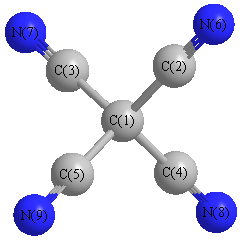Vibrational Frequencies calculated at MP2/CEP-121G*
| Mode Number |
Symmetry |
Frequency
(cm-1) |
Scaled Frequency
(cm-1) |
IR Intensities
(km mol-1) |
Raman Act
(Å4/u) |
Dep P |
Dep U |
|---|
| 1 |
A1 |
2110 |
2011 |
0.00 |
|
|
|
| 2 |
A1 |
577 |
550 |
0.00 |
|
|
|
| 3 |
E |
549 |
523 |
0.00 |
|
|
|
| 3 |
E |
549 |
523 |
0.00 |
|
|
|
| 4 |
E |
105 |
100 |
0.00 |
|
|
|
| 4 |
E |
105 |
100 |
0.00 |
|
|
|
| 5 |
T1 |
311 |
296 |
0.00 |
|
|
|
| 5 |
T1 |
311 |
296 |
0.00 |
|
|
|
| 5 |
T1 |
311 |
296 |
0.00 |
|
|
|
| 6 |
T2 |
2121 |
2021 |
35.77 |
|
|
|
| 6 |
T2 |
2121 |
2021 |
35.77 |
|
|
|
| 6 |
T2 |
2121 |
2021 |
35.77 |
|
|
|
| 7 |
T2 |
1080 |
1029 |
36.95 |
|
|
|
| 7 |
T2 |
1080 |
1029 |
36.95 |
|
|
|
| 7 |
T2 |
1080 |
1029 |
36.95 |
|
|
|
| 8 |
T2 |
534 |
509 |
0.66 |
|
|
|
| 8 |
T2 |
534 |
509 |
0.66 |
|
|
|
| 8 |
T2 |
534 |
509 |
0.66 |
|
|
|
| 9 |
T2 |
134 |
128 |
10.88 |
|
|
|
| 9 |
T2 |
134 |
128 |
10.88 |
|
|
|
| 9 |
T2 |
134 |
128 |
10.88 |
|
|
|
Unscaled Zero Point Vibrational Energy (zpe) 8267.6 cm
-1
Scaled (by 0.9528) Zero Point Vibrational Energy (zpe) 7877.4 cm
-1
See section
III.C.1 List or set vibrational scaling factors
to change the scale factors used here.
See section
III.C.2
Calculate a vibrational scaling factor for a given set of molecules
to determine the least squares best scaling factor.
